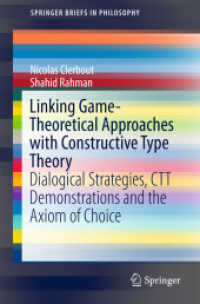- ホーム
- > 洋書
- > ドイツ書
- > Humanities, Arts & Music
- > Linguistics
- > general surveys & lexicons
Full Description
This book examines intra-individual variability and inter-individual variation in the emergence of syntactic complexity, accuracy, lexical complexity, and fluency (CALF) in L2 English writing at secondary school from the perspective of complex dynamic systems theory (CDST). It presents a mixed-method study based on the Written English Developmental Corpus of Polish Learners (WEDCPL), which consists of over 1900 texts written by 100 learners during 21 repeated measurements conducted over a period of three years at secondary school. The study provides both group and individual data on language development, dynamic relationships between selected variables, significant peaks and phase transitions in language development, patterns of intra-individual variability, the growth rate of language development, and the relationship between intra-individual variability and the average semester growth rate of language development. The book is addressed to SLA researchers, methodologists, foreign language teachers, and students.
Contents
Introduction.- PART 1: Theoretical, methodological and empirical issues in CDST.- CHAPTER 1 Complex Dynamic Systems Theory.- CHAPTER 2 Variability in SLA and SLD.- CHAPTER 3 Complexity, accuracy and fluency in L2 writing.- PART 2 Investigating the Role of Intra-individual Variability in the Emergence of Complexity, Accuracy and Fluency in L2 English Writing at Secondary School-The Panel Study.- CHAPTER 4 The Panel Study-Rationale and Design.- CHAPTER 5 The Panel Study-The results.- CHAPTER 6 The Panel Study-The Discussion of the Results.- PART 3 Examining the Role of Intra-individual Variability in the Emergence of Complexity, Accuracy and Fluency in L2 English Writing at Secondary School-The Case Study.- CHAPTER 7 The Case Study-Rationale and Design.- CHAPTER 8 The Case Study-The Results.- CHAPTER 9 The Case Study-The Discussion of the Results.- Conclusions, Implications and Suggestions for Future Research.








